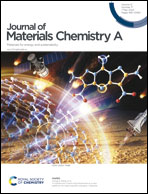Design of S, N-codoped Co–Fe dual-atom sites for efficient alkaline oxygen reduction†
Abstract
Heteronuclear dual-atom site catalysts exhibit exceptional electrocatalytic performance due to their coordination environments and local structures for electron transfer by introducing heteronuclear metal sites. Additionally, atomic interface tuning has been considered an effective strategy to further tune the performance of diatomic catalysts. In this research, we rationally designed and synthesized Co–Fe dual-atom sites on S, N-codoped carbon (Co–Fe–SNC) through a practical strategy. Benefiting from the synergistic interaction between atomically dispersed bimetallic sites and further surface regulation by S atoms, the obtained Co–Fe–SNC sample exhibits excellent electrocatalytic activity for the oxygen reduction reactions (ORR). Furthermore, density functional theory (DFT) calculations revealed that the heteronuclear dual-atom sites of Co–Fe–SNC effectively altered the rate-determining step of the reaction, and the presence of S atoms further optimized the adsorption and desorption energy barriers of ORR intermediates. This work proposes novel atomically tunable dual-atom site catalysts, which can serve as a valuable reference for the design and development of highly efficient ORR electrocatalysts with practical applicability.

- This article is part of the themed collection: 2024 Journal of Materials Chemistry A HOT Papers


 Please wait while we load your content...
Please wait while we load your content...